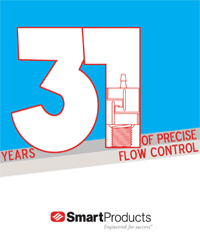 With over 22 years of experience in using ozone as a natural sanitizer, McClain Ozone offers mobile cleaning and sanitizing solutions in a variety of industries. Within their Ozone Sanitation Systems, they use two custom-made Smart Products NPT style check valves: the Model #314 and the Model #204. With over 22 years of experience in using ozone as a natural sanitizer, McClain Ozone offers mobile cleaning and sanitizing solutions in a variety of industries. Within their Ozone Sanitation Systems, they use two custom-made Smart Products NPT style check valves: the Model #314 and the Model #204.
"The Smart Products check valves were selected initially due to the availability of the connections, a 1/8" MNPT and a 1/4" FNPT, as well as the seal materials. We have since transitioned through several types of seal materials and have come to rely on the consistent quality of the products, but more so on the valuable input from the Product and Application Specialists at Smart Products," says CEO John McClain.
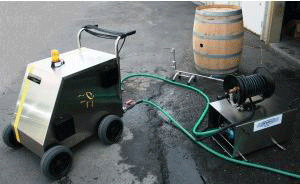 Especially popular with the wine and brewing industries, McClain's Ozone Sanitation Systems are used to sanitize barrels, vats, bottling lines, and processing equipment. They can also be used for gassing barrel rooms. Especially popular with the wine and brewing industries, McClain's Ozone Sanitation Systems are used to sanitize barrels, vats, bottling lines, and processing equipment. They can also be used for gassing barrel rooms. 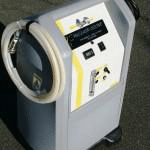 Additionally, McClain provides sanitation and gassing systems to a wide variety of other marketplaces. From mitigating bed bugs and insects in hotels, homeless shelters, etc. to sanitizing drinking water tanks for airlines and beyond, McClain's use of ozone provides a natural, yet very powerful sanitizer. Additionally, McClain provides sanitation and gassing systems to a wide variety of other marketplaces. From mitigating bed bugs and insects in hotels, homeless shelters, etc. to sanitizing drinking water tanks for airlines and beyond, McClain's use of ozone provides a natural, yet very powerful sanitizer.
For precise flow control in McClain's systems, the Model #314 is used in both the oxygen gas line and the ozone gas line. This valve protects the oxygen concentrator from water, in the event there is problem with the system or a customer's hook-up connection point. The Model #204 check valve is used as part of the safety system. Like all Smart Products valves, both the #314 and #204 were uniquely built by plastic body, o-ring, and opening PSI exclusively for McClain Ozone.
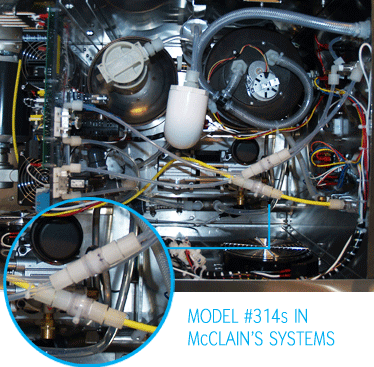
Available in the United States, Europe, South and Central America, Canada, Mexico, Australia, and New Zealand, these units provide "ozone on demand" sanitation solutions. To learn more about McClain Ozone, click here.
If you're looking for a NPT check or pressure relief valve, Smart Products offers several options in addition to the #314 and #204, to include the Model #103 and Model #109, Model #312, and all Series 200 valves. Both the Series 300 and Series 200 are modular style valves, which allows further customization with their mix and match end fitting options.
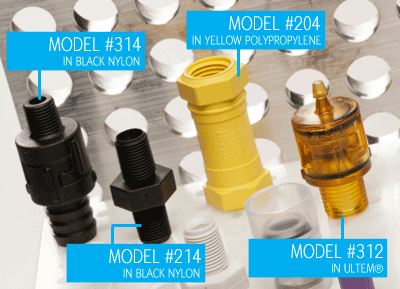
For assistance with your own unique low pressure, low flow project, contact us at (800) 338-0404 or sales@smartproducts.com.
Series 500 Luer Styles
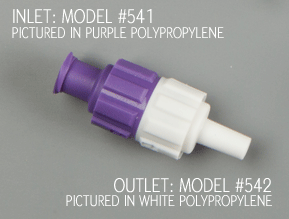 If you're looking for an all-in-one Luer and check valve solution, we offer the Model #541 Female Luer Lock and Model #542 Male Luer valves. Especially popular in the medical industry, we offer these Luer style end fitting options as an inlet or outlet in our Series 500 Check / Pressure Relief Valves. If you're looking for an all-in-one Luer and check valve solution, we offer the Model #541 Female Luer Lock and Model #542 Male Luer valves. Especially popular in the medical industry, we offer these Luer style end fitting options as an inlet or outlet in our Series 500 Check / Pressure Relief Valves.
Once assembled, our Series 500 valves are tamper-resistant and eliminate the leak prone adapter seen in other valves by combining the inlet, outlet, and check valve in one piece.
The Model #541 is a Female Luer Lock style offered in Polypropylene, PVDF, Polycarbonate, and Ultem®. The Model #542 is a Male Luer available in Polypropylene.
O-ring materials available for any valve in this series include Buna-N, EPDM, Viton®, Silicone, and Fluorosilicone. Opening spring pressures range from 0.09 to 20 PSI. Like all of our valves, the #541 and #542 are made to order with customizable components to ensure precise performance within a specific design criteria.
To discuss your current and future application requirements, give us a call at (800) 338-0404 or email sales@smartproducts.com.
To view a PDF of our entire product catalog, click here.
How does a check valve work?
When you're creating a low pressure, low flow application, it pays to understand how check valves work.
- Will a certain step affect your device's performance?
- Is there a part in the operation process that will be critical to your application?
Watch our new video to see where the differences in opening, steady state, and closing actions come into play.
|
